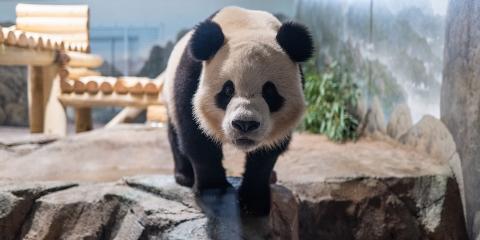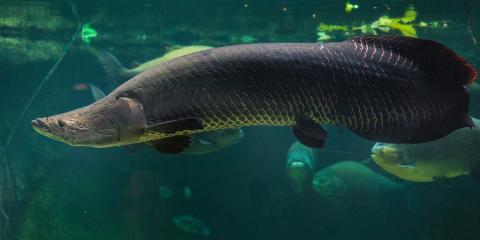Physical Description
Japanese giant salamanders have wrinkled skin mottled with varying patterns of black and shades of brown. Some appear quite dark, while others have lighter patches of browns. Like their North American cousins, Japanese giant salamanders have flat heads, elongated bodies and long, broad tails. They have small eyes and rely on their other senses to detect prey. This species does not exhibit sexual dimorphism (distinct differences in appearance between males and females), except during the breeding season when males develop a swollen cloaca.
Like other salamanders, Japanese giant salamanders "breathe" primarily through their skin. The smooth skin acts as a respiratory surface for gas exchange, where oxygen enters the body and carbon dioxide is released. Flaps of skin, or wrinkles, increase the surface area for this respiration. These salamanders do have a single lung, but it is used primarily to control their buoyancy in the water.
When aggravated or stressed, Japanese giant salamanders secrete a sticky, white mucus that may be toxic to predators. The sticky secretion has a pungent odor and smells like Japanese peppers. This has given them a common name in Japan that translates to "big pepper fish."
Giant salamanders have amazing regenerative capabilities and are able to regrow skin and bone, if necessary. Japanese giant salamanders belong to the Cryptobranchid family, which includes three regionally distinct salamanders: Japanese giant salamanders, Chinese giant salamanders and North American hellbenders.
Size
Native Habitat
Japanese giant salamanders are native to Japan and can be found in the country's central highland mountainous regions. A few populations have also been discovered living on some of the smaller souther islands adjacent to the main island of Japan.
Giant salamanders are mostly aquatic and live in cold, fast-flowing water where oxygen is in good supply. These sites are often rivers in forested and mountainous areas. During the day, Japanese giant salamanders hide under large rocks along the water's edge to stay concealed.
Lifespan
Food/Eating Habits
Japanese giant salamanders are carnivorous and eat a variety of animals, including fish, insects, crayfish, snails and small mammals. They have extremely slow metabolisms and can go weeks without eating, if necessary.
They have poor eyesight, so they rely on smell and vibrations in the water when hunting. Bumps on their skin, located mostly around the head, are actually external sensory organs that operate similarly to the lateral line system in fish. The giant salamander captures prey in its mouth, which is full of tiny teeth. In combination with the significant jaw pressure from its muscular head, prey typically cannot escape this salamander's grasp.
At the Smithsonian's National Zoo, Japanese giant salamanders eat fish, shrimp, earthworms and crayfish.
Sleep Habits
These salamanders are nocturnal, meaning they are generally active at night.
Social Structure
Males and females have overlapping home ranges and are more or less sedentary and solitary except during the breeding season. In August to September, both sexes congregate at underwater nest sites, consisting of 39 to 59 inch (100 to 150 centimeter) long burrows into or near the riverbank.
Reproduction and Development
These salamanders spawn from August through October. During this season, they migrate upriver looking for "dens" — caverns or burrows, each containing a single underwater entrance. The largest, most dominant male in a territory of river will occupy the den and defend it.
During the breeding season, multiple females may enter the den and spawn with the male. Females typically lay a clutch of 400-600 eggs. Once the females have laid their eggs and the male has fertilized them, the females leave the den. It is now the male’s job to provide protection, while the eggs develop and hatch. This incubation period ranges from 40-60 days. The male, sometimes referred to as the "den master," guards and protects the nest for a couple of months until the juvenile salamanders go off own their own.
Conservation Efforts
Japanese giant salamanders are considered near threatened by the International Union for Conservation of Nature and are also listed on CITES Appendix I.
In 1952, Japan designated this animal as a special natural monument, making hunting it illegal. However, these salamanders are still sometimes hunted for their meat, which is considered a delicacy in parts of Japan. They are also used in some traditional medicinal practices. Habitat loss, alteration and degradation continue to be the major threat to these salamanders. Sedimentation from agriculture, mining, logging and the construction of dams makes it difficult for the salamanders to get the adequate amount of oxygen they require. Additionally, it makes traveling upriver to breeding sites extremely difficult.
A lack of genetic variation may also impact this species, especially as populations of Japanese giant salamanders are reduced. Cases of hybrid salamanders have been recorded in the wild, due to the accidental release of imported Chinese giant salamanders. The larger, more aggressive Chinese giant salamander now occupies some of the same crucial habitat that the native Japanese giant salamander relies on.
Zoos and aquariums play an important role for species threatened in the wild, including the Japanese giant salamander. The Smithsonian's National Zoo and Conservation Biology Institute is a leader in research on the reproductive biology of this species. Experts are also interested in learning more about a type of amphibian chytrid fungus that is unique to Japanese giant salamanders and does not seem to impact other amphibian species in Japan.
The Japanese giant salamanders at Reptile Discovery Center are gifts from ASA Zoo in Hiroshima, Japan. By understanding their habitat needs, metabolic functions and morphology, the Smithsonian hopes to be the first North American institution to breed Japanese giant salamanders, and to contribute to the growing body of knowledge on salamander disease.
Help this Species
- Practice ecotourism by being an advocate for the environment when you’re on vacation. During your travels, support, visit or volunteer with organizations that protect wildlife. Shop smart too! Avoid buying products made from animals, which could support poaching and the illegal wildlife trade.
- Support organizations like the Smithsonian’s National Zoo and Conservation Biology Institute that research better ways to protect and care for this animal and other endangered species. Consider donating your time, money or goods.
- Share the story of this animal with others. Simply raising awareness about this species can contribute to its overall protection.


